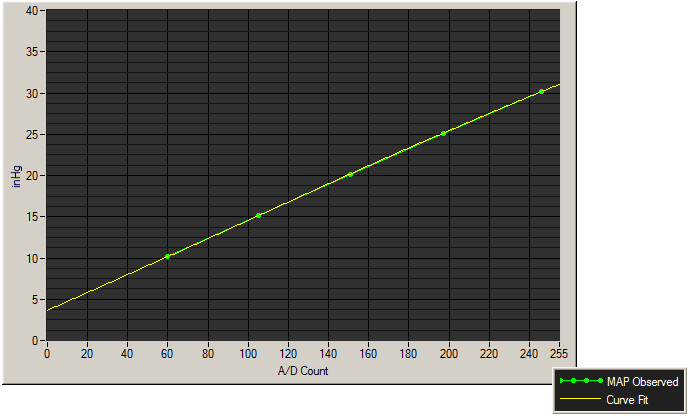theogre,
You are a well of knowledge! Thanks. That is a great page you have! I am going to study it some more.
Just be sure we are on the same page...
Vacuum means two things to me: Absolute Vaccum based on a scale starting from 0, or relative pressure changes where a reduction in pressure from ambient pressure is a "vacuum" (like in the intake manifold) and increases (negative vacuum) above ambient pressure, that is "pressure" as opposed to vacuum in this sense (say in a boosted intake manifold). Either way, they translate to some PSIA value.
So those voltages out of the MAP do translate to A/D counts in the ECM which are reported by the ALDL.
Various Absolute Pressures = Various Voltages = Various A/D values in the ECM = Various Values reported as the MAP Variable in the ALDL data stream.
That is what I am trying to determine over the full dynamic range of the MAP sensor and ALDL.
Yes, I figured that the initial reading before the engine is started is the current atmospheric pressure which on the absolute scale is about 14.7 PSIA (Yes, 0 = pure vaccum - there is actually nowhere in free space where PSIA is true 0.0 even in intergalactic space, there are still a few molecules per cubic meter and thus a pressure in micro Torr. Ok, we are nowhere near those levels [whew!]
From your page, the voltage when at 14.7 PSIA gives me one data point in the ALDL data range of 0 to 255. I just need to get a few more data points to correlate other PSIA pressures to ALDL values. For example, when the engine revs, vacuum will be introduced in the intake manifold. So, say, a 10 inHg of vacuum = a drop of about 1.7V from the MAP = something less than 14.7 PSIA. This new lower absolute pressure is converted to a lower voltage by the MAP sensor, and the ECM converts this voltage to a value different from the initial reading (but still somewhere between 0 and 255, but to what value?).
So what I need is to know is when the pressure drops by 10 inHg, what value does the ECM report.
And say for several further drops of about 10 inHg each until its at a level not practically experienced in the manifold or the MAP sensor minimums out.
And why not go the other way for increases in pressure of about 10 inHg - to report pressures above 14.7 PSIA which is not normal in a non-boosted engines (like mine, correct?)..
but good to know if it happens.
If I could make something that can "statically stable" put various calibrated levels of vacuum, that is pressures below 14.7 PSIA into the MAP sensor (pressures of > 0 PSIA but less than ambient PSIA of about 14.7) of say in 10 inHg steps down, then I can correlate those absolute pressures to ALDL values reported.
That is crux of my investigation.
Any ideas? Money is an issue here. My CFO (wife) has given me a budget of $0. [laugh]
------------------
Paul Romsky
[This message has been edited by Romsk (edited 08-21-2022).]


















